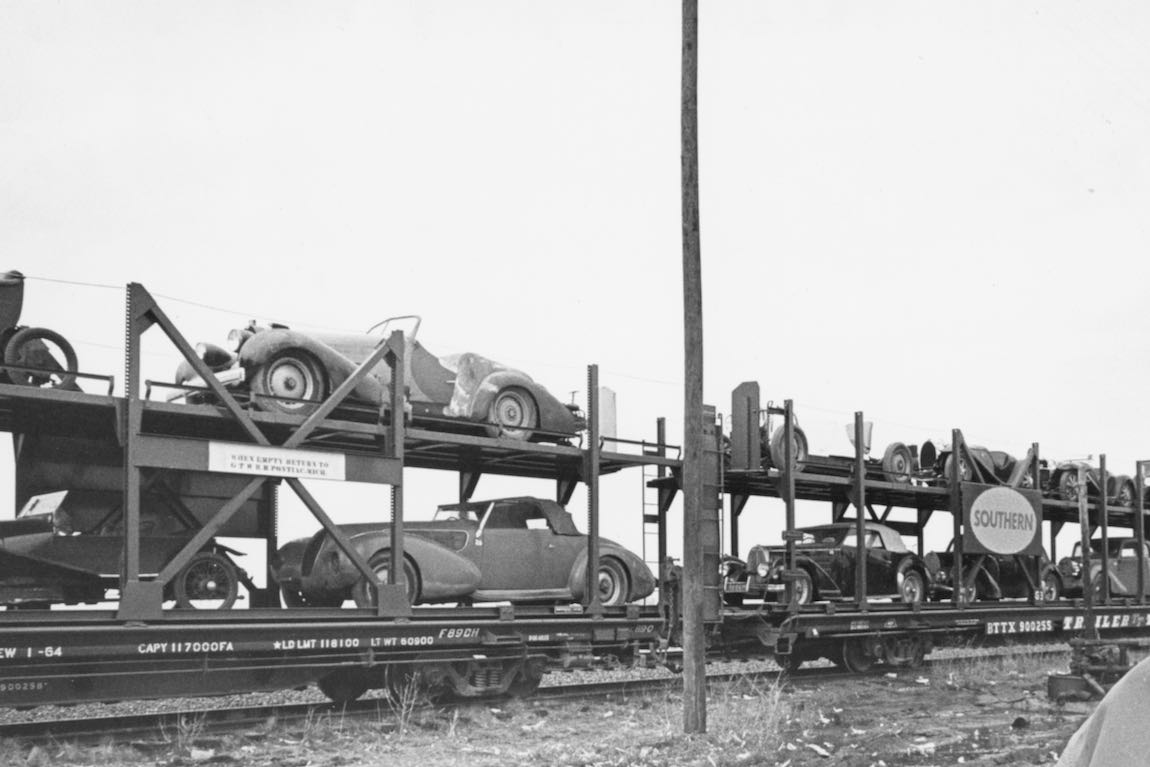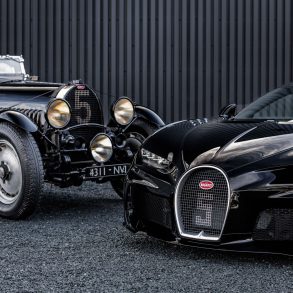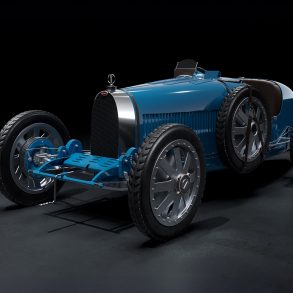Around 60 years ago, Fritz Schlumpf purchased a collection of thirty Bugatti models after tough negotiations. He simply adored Bugatti: Schlumpf had to own as many of the vehicles as possible because he wanted to use them as a basis for establishing the biggest Bugatti collection in existence. In fact, it became something of an obsession, as reflected in the negotiations with an American Bugatti owner that went on for at least two years.
Bugatti and Schlumpf are two names that have been linked together for a long time. Fritz Schlumpf bought his first Bugatti at the age of 22 in 1928 and drove it on weekends and in car races. The car enthusiast kept in touch with the Alsace-based company Bugatti over the coming years, although his passion for collecting didn’t really develop properly until 1961.
Schlumpf initially worked as a wool broker, and in 1929 his brother Hans — two years his senior — joined the textile company. In 1935, they founded Société Anonyme pour l’Industrie Lainière (SAIL), a limited company trading in wool. After the war, the brothers bought up several factories and spinning mills in Alsace until they almost fully dominated the textile industry in eastern France.
In 1957, they acquired a vacated wool factory in Mulhouse, Alsace, in order to build their own automobile museum: in honour of their beloved mother and Ettore Bugatti, but mainly for Fritz Schlumpf himself. After all, collecting Bugatti cars had long become his obsession. From 1961 onwards, he acquired numerous classic vehicles and eventually became the leading Bugatti collector.
Schlumpf Contacts Bugatti Owners Worldwide
In order to achieve this, Schlumpf wrote to Bugatti owners all over the world in the early 1960s. He obtained the addresses from a register kept by Hugh Conway of the British Bugatti Owners Club, who put him in touch with American collector John W. Shakespeare from Hoffman, Illinois, USA in 1962.
Shakespeare had dedicated himself to collecting Bugatti vehicles since the 1950s: his first car was a 1932 Bugatti Type 55; this was followed by a Type 41 Royale Park Ward, the third and last customer car, twelve Type 57, three Type 55, and Ettore Bugatti’s personal electric car Type 56 dating back to 1931. All in all, Shakespeare owned the largest Bugatti collection in the world, comprising some 30 vehicles.
Schlumpf simply had to get hold of these cars and made Shakespeare a lump-sum offer of USD 70,000. But the latter demanded at least USD 105,000, whereupon Schlumpf had the collection assessed by Bugatti connoisseur Bob Shaw from Illinois in 1963.
Shaw arrived at an unflattering conclusion: “Most of the cars are kept in a part of the building with a dirty floor, broken windows, leaking roof and nesting birds. Every car is in some state of disrepair and none of them have been running for at least 18 months.”
While Shaw advised against the purchase, Schlumpf was fully committed by this time and offered Shakespeare USD 80,000 for the entire collection. After tough negotiations, mutual threats and blackmail, Schlumpf and Shakespeare finally agreed on a purchase price of 85,000 dollars the following year (equivalent to approximately USD 720,000 today) – including transport to France. From today’s point of view, it was more than just a good deal — in fact it was a real bargain.
Thirty Vintage Bugattis on One Train
On 30 March 1964, the thirty historic Bugattis left Illinois on a Southern Railway train heading for New Orleans where they would be loaded onto a Dutch cargo ship. A photo shows the open train with the large number of rare vehicles. A few weeks later, the freighter reached the French port of Le Havre, where Fritz Schlumpf finally received his treasure.
Schlumpf was now one huge step closer to achieving his goal of being the biggest Bugatti collector in the world. It wasn’t until 1965 that the Schlumpf brothers publicised their collection in a short press release — and the idea of a museum was born. But Fritz Schlumpf never officially opened it.
The Schlumpf brothers had little opportunity to enjoy their unique car collection, and their pleasure in these wonderful cars was only to last a few years: large-scale strikes occurred after they engaged in questionable business practices, and the decline of the French textile industry in the 1970s eventually meant they were forced to flee to Switzerland. The story of the amazed workers who came across the secretly hoarded treasure in 1977 has gone down in automotive history.
What remains are the exclusive vehicles, showcased in an extraordinary exhibition: the Schlumpf collection is now located in the “Cité de l’Automobile” national museum in Mulhouse in the heart of Alsace — the largest automobile exhibition in the world. Covering an area of more than 25,000 square metres, the exhibition comprises 400 of the world’s rarest cars — including around 100 Bugatti models, such as two of just six Type 41 Royale ever built. One of them is the former Shakespeare vehicle with the Park Ward bodywork. Other models from the group of 30 vehicles are to be found in their original unrestored condition at the Mullin Automotive Museum in Oxnard, California. There and in Alsace, visitors can admire them after their almost 60-year odyssey.
[Source: Bugatti]











there was a photo of the cars on a train in some major magazine back in the day–just a bunch of kinda nice old cars
toly, do you still have a morgan , I , was ther when you won the scca class championship . i,m the owner of a 67 plus4 #6540 rhd ,roadster for 40 years , here in louisville ky .any parts or accessories . My wife visired the Works in 1974 on our honeymoon soljurn to england . glad you are still afound Rock On .. Dennis Risher I saw the Royal Bug at the then Harrhas auton museum when it was still whole and there in Las Vegas .
Dennis…..My Morgan #6540. They may have traveled together through the factory. Back to this great story on Bugattis. There is a nicely done Pur Sang in my area that comes out for Cars & Coffee and a few shows. It is rumored to have a lot of original parts. Don’t know much about the history but this article may prompt me to learn more.
I still have the street 4/4 series v comp! haven’t driven it in awhile since the missing leg! but I can drive a stick–just need easy access to the handbrake, be well! toly
The best article on this is in Automobile Quarterly , l came across it years ago. Shakespeare was the scion of the fishing rod and reel company people and had mad amounts of cash at one time. He was a real character by all accounts.
This story does contain a lot of the information from the AQ feature, indeed, the pictures are the same, save for the new material about the Mullin exhibit.
SCD neglected to mention how John Shakespeare met his demise; he was found tied to a chair in his basement and shot, execution style! I do not recall the year that took place, but still mid-late 60s time frame.
Imagine having some thirty (>30) project Bugattis today, including the Type 41 Royale; I’d NEVER want to leave the workshop!
wasn’t scca race driver bobby aylward found in a similar condition in Wichita decades ago?
Some years ago I sold a Sunbeam Tiger registered MMU 887C to the New Orleans area of the USA. It was eventually used for SCCA racing and I wondered if anyone remembers this wide wheeled (red ) car. However as this email is about Bugattis I can contribute a little information to the discussion. I was lucky enough to look after a T54 Bugatti for a year or so in the UK which was a delight to drive and very quick even though it had negligable braking capability. I over the years have also been entrusted with a couple of T57 and a T51. Though the 51 was not a ‘real’ car it was built by Pur Sang in south America to a staggering level of accuracy, in must areas anyway. My record was driving the car some 480 miles in 1 day. I ended up almost deaf and VERY stiff. I was only around 60 at the time, now at 72 I would not dream of trying the same thing again ! Overall the Pur Sang car was excellent. Tyres were rubbish as Argentinian made, body work excellent. engine and gearbox identical to original – indeed everything cross fits – so a number of 51 mechanical parts are today used to keep original cars on the road (or Track ) The engine runs on shell bearings which is a generally good thing for longlevity as roller bearings are very short lived. Incidentally when I visited Mulhouse many years ago – the one car the Schlumphs failed to get was a T54. Nowadays I try to play with Talbot Lago’s. Has anyone got a spare Talbot Lago 4 litre prewar 6 cylinder engine for sale ???
Bob Shaw is still with us and doing well in spite of his advanced age…
Indeed Bob Shaw is still with us! I know him personally and have asked him to recount his participation and contribution to the negotiations between Mr. Shakespeare and the Schlumpf brothers on a few occasions because the story is fascinating especially told by the person who was right in the middle of this. We’ll never know whether the Schlumpf brothers were the actual vilains but in the eye of the French government of the time as well as in the eye of the factory workers who supposedly were not getting paid, they were and this is why they had to flee to Switzerland. The museum in Mulhouse is a “must see”!
If you read the latest book as mentioned below you will see the Schlumpf brothers were not, as you say “the actual villains”. Without giving too much away, (everyone with an interest needs to read it) the true story was that when it became clear that the textile industry was suffering in France, as elsewhere due to cheaper Asian imports, the brothers did try to follow up on more than one potential deal to save their business and ensure the workers were paid but other political interests blocked their attempts. The authors interviewed people with first-hand knowledge and have evidence to clear the brothers’ names.
I know this incredable story, I have been to their awesome unique museum in Mulhouse, France !
Lucky they didn’t spend the the money to their textile factories !
Han Klems, Netherlands
Well they did try to save the factories, read the book!
the book of the story of the SCHLUMPF collection was outlaw in France, I receive this book in english languish while visiting friends in london february 1978!!
the clothing mills workers upset about loosing their job took one of the oldest car from the SCHLUMPF collection & warn that thei would start by setting on fire the oldest car!!
Great story. I’m seeing some of these photos for the first time.
It was the AQ article in the 1970s (Road & Track may have also printed a story) that inspired me to visit the museum on my first and only trip to France in 1983. You can see my photos from that visit here: https://richardscarblog.com/2016/03/13/bugatti-cars-at-the-schlumpf-museum-march-1983/
I understand from friends who have visited more recently that the interior has been largely redesigned, but of course, the Bugattis are still there.
We were the official videographers for Harrah’s Automobile Collection’s Final Auction, in 1986. There was a special “Evening Royale” from which we which we produced this program, ““The 1931 Bugatti Royale Berline du Voyage”
“The Golden Bug” – the name fondly given to Ettore Bugatti’s most luxurious autombile, the Bugatti Royale Berline de Voyage. William F. Harrah crowned his 1,400-piece automobile collection with not one, but two of these thoroughbreds built for royalty. During Harrah’s third and final auction on June 27, 1986, history was made, when a Texas millionaire became the new owner of the Berline de Voyage. The princely sum of $6.5 million dollars was the winning bid for the Royale, setting a new Guinness Book Record as the most expensive automobile in the world!
This DVD chronicles the distory of the Berline de Voyage, as well as the five other Royales that preceded it. Join the bidders at Harrah’s “Evening Royale,” and experience the most exclusive automobile sale ever. Tour the Royale and inspect the 8-cylinder, 300 horsepower engine, and enjoy a detailed look at the chauffeur’s and passenger’s compartments, along with the many unique features of this remarkable Bugatti.
The 1931 Bugatti Royale Berline de Voyage and “Evening Royale” is an essential addition to every automobile enthusiast’s library. 55 mins.
You can order this DVD, plus our program about the Final Auction for only $20, which includes shipping, or just the Bugatti program alone for $10.
Go to: https://www.videovelocity.tv/product-page/the-1931-bugatti-royale-berline-de-voyage
and : https://www.videovelocity.tv/product-page/the-1986-harrah-automobile-collection-final-auction-classic
Just a few notes to add to the story above:
The story of the Schlumpf brothers has always painted the picture of two avaricious hoarders who spent a fortune on their hobby while at the same time running down the French textile industry and exploiting their workers. There were two well-known books published some time back; L’Affaire Schlumpf by Laffon and Lambert, and ‘The Schlumpf Obsession’ by Verstappen and Jenkinson which both perpetuated some of this version of events.
However, in 2017 two Dutch enthusiasts Ard op de Weegh and his son Arnoud op de Weegh published ‘Schlumpf – The Intrigue Behind The Most Beautiful Car Collection In The World’ which contains a very different account of the who, how and why. This is essential reading for anyone interested in Bugattis, the Schlumpf story or even just wanting to know the truth behind a well-known mystery.
Things could have been very different were it not for interference from others for political reasons, and the brothers, it seems, were not the villains of the story after all.
I have each of the above books but reading this today on SCD prompted me to dig out the Automobile Quarterly version of events.
Volume 34 # 3 has a ten page story by one Don Sherman who does his best to paint a vivid picture of the protagonists:
So John Shakespeare was described as a “wealthy midwestern sportsman” who “could do whatever he pleased” thanks to his inherited wealth and the collection of Bugattis was just a “dalliance slotted between waterskiing and skydiving”.
Fritz Schlumpf meanwhile was described thus; “a despotic European industrialist who methodically converted the sweat of thousands of textile workers into one of the world’s most valuable car collections”.
As I said above, the latest book by the de Weegh duo will hopefully become the standard reference about this whole affair and right a few wrongs.
It was a David Gulick of the St. Louis Post-Dispatch Sunday Pictures magazine who took the famous photos of the cars being loaded on to the train.
The name of the Dutch cargo ship was the ‘Grotedyk’.
Shakespeare was murdered in 1975 and the case remains unsolved.
As an aside to the acquisition by Peter Mullin of the ‘reserve collection’ a few years ago when this deal was still supposedly a secret I tracked down a delapidated Montier-Ford (a 1920s Parisian hot-rod if you like) which had been in the Malmerspach warehouse to Mullin’s Oxnard facility. When I finally received confirmation that it indeed had been bought with the rest of the cars from Arlette Schlumpf’s estate (Fritz’s widow) I was told Mr Mullin had no plans to either restore it or display it in his museum. So I asked in that case would he sell it to someone who would restore it. He asked what was my offer and then said it is not for sale. I tried again a couple of years later and received the same reply “what is your offer” and when, presumably, it was still not high enough, I was told it was not for sale again.
The twist this time was that Mr Mullin told me he believed it had once been the property of Ettore Bugatti himself.
Now it gets weird.
First, I wondered why would Ettore Bugatti have wanted a cheap crude Model T Ford based speedster anyway/
Second point; Mullin himself by that time had access to the files of Schlumpf’s correspondence regarding all of the cars he bought. These records are now at the Mulhouse museum and confirm that while Schlumpf did indeed buy a Model T Ford from the final winding up of the Bugatti estate in 1965 it was in fact a standard model and noted as ‘lacking an engine’. The records show the Montier was bought from a M. Sipp in Marseilles in 1961.
I even received mysterious enquiries from a third party who was apparently fishing to find out why I was trying to buy the Montier; I guess he thought I must know something he didn’t about its history that would add value, but no, it is just one of those obscure curios I wanted to see saved; whether by me or Mr Mullin’s staff is not important as long as it is not just left neglected in a warehouse for another sixty years.
The point of this story?
Maybe the spirit of Shakespeare and Schlumpf as slightly eccentric wealthy hoarders lives on.
Excellent story and images, thank you.
Back in 2008 I cycled from Basel to Mulhouse to visit the Schlumpf museum. It is truly a fantastic museum. I real hidden gem.
I had the chance to visit the “Schlumpf museum” few years before it was opened to the public. it was around 1978…We were only 3 people inside ! Great time!
I bought Bugattu 38 292 in 19953 for $286 inMetz, France . Had the mechanical work done at the factoory. The U.S. Army shipped it for me to New York. I sold it to Glen Harrison of the Chicago area for $1200 they Zamboki Motors (ap). Bob Shaw ended up with it, modified it and then sold it to the Axhlumpfs It is now in the mmuseym. If anyone wants to get touch with me I am at 352 216 4244 or 4225. Jack Eubank,Dunnellon,Florida.
Wonderful story, and kudos to Bob Shaw for holding the deal together!
There is a very odd story about Shakespeare and Lancias… possibly off topic. Forgive if not interested, but here we go:
Years ago, c. 1990s or so, Bill Knauz (Lake Forest, old time car dealer) had a lovely green two tone Lancia Aurelia B20 for sale. It had a wonderful original leather interior, rarely found. It had come from Shakespeare’s collection, but oddly had a B24 motor in it. Nearby was another motor, and an Aurelia transmission. Walt Spak went back later and bought the engine and trans. He took the trans apart, and it was strangely just like new – some 40 years after it had been made. It was all quite strange.
About twenty years later, Steve Katzman was talking to a Moto Guzzi restorer at Monterey who told him of a new B24 Spider that was crashed c. 1955 in Indianapolis, after only a few months on the road. Shakespeare bought the wrecked car, thinking it probably had a souped up engine. He put the Spider engine in his B20. It took a while, but that explained why the B20 had the wrong engine, and that the transmission was so new – it was from the B24 and had barely been used.
The B20 was sold to Japan, then came back through a Philly dealer, who was uninterested in the original motor. No idea where it is now.
Shakespeare must have been an interesting guy.